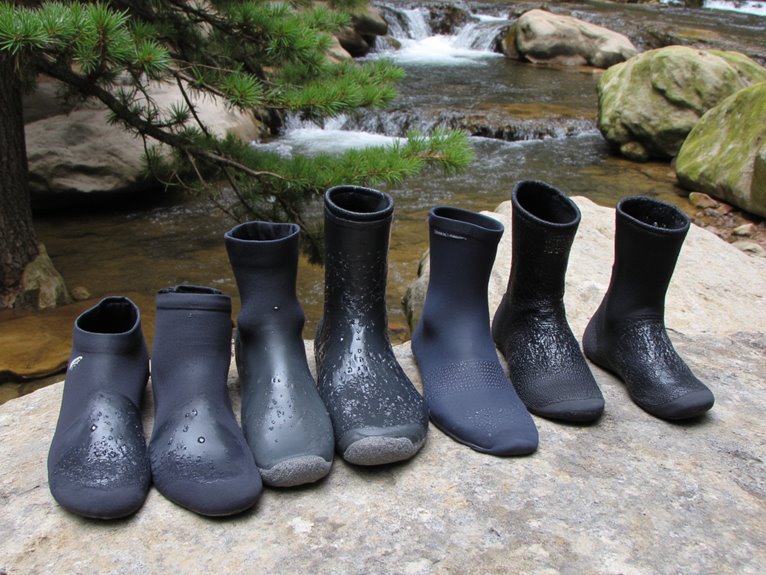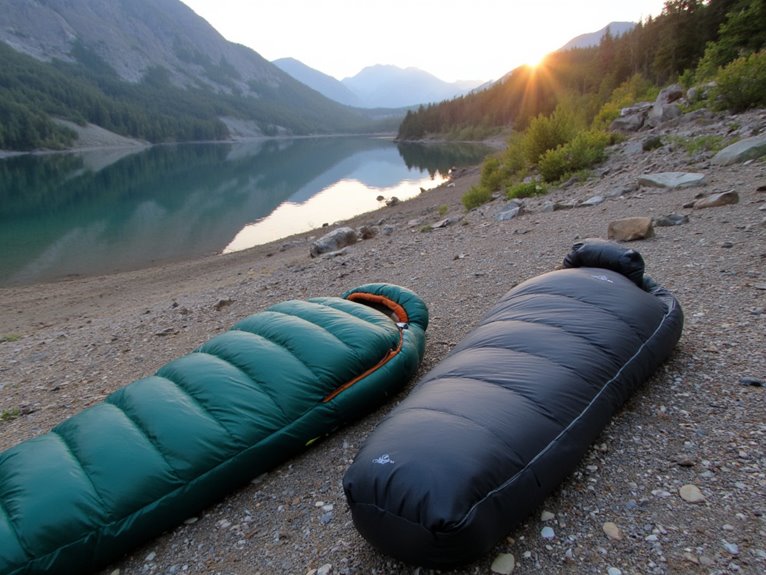How Safe Are Tent Stoves?
Tent stoves can be a safe and efficient way to heat a tent, but they require careful installation, maintenance, and use to prevent accidents and guarantee a safe camping experience. While they offer many safety features, such as spark arrestors and heat shields, they can still pose hazards like burns, fires, and carbon monoxide poisoning if not handled properly. By understanding the risks and taking precautions, campers can enjoy a safe and comfortable outdoor adventure. To guarantee a safe and enjoyable experience, it's essential to stay informed about the best practices and guidelines for tent stove safety.
We are supported by our audience. When you purchase through links on our site, we may earn an affiliate commission, at no extra cost for you. Learn more. Last update on 6th January 2026 / Images from Amazon Product Advertising API.
Tent Stove Safety Features
Integral to the design and functionality of tent stoves are safety features that mitigate risks associated with combustion, heat, and fuel handling. These features are vital in preventing accidents and ensuring a safe camping experience.
A key safety feature is the spark arrestor, which prevents sparks from escaping the stove and igniting surrounding flammable materials.
Another essential feature is the heat shield, which protects the tent fabric from excessive heat.
Additionally, many modern tent stoves come equipped with automatic shut-off valves that prevent fuel leaks and uncontrolled combustion.
In addition, some stoves feature child-resistant locks to prevent accidental ignition.
Common Hazards and Risks
While tent stoves are designed with safety features to mitigate risks, they are not immune to hazards, and understanding common hazards and risks is essential to guarantee a safe camping experience.
One common hazard is the risk of burns from hot surfaces, sparks, or embers.
Additionally, tent stoves can be a fire hazard if not properly installed, maintained, or monitored.
Improper ventilation can also lead to a buildup of condensation, causing moisture issues within the tent.
In addition, the stove's fuel and electrical components can be a shock or fire hazard if not handled correctly.
Carbon Monoxide Poisoning Dangers
When using tent stoves, carbon monoxide poisoning is a silent yet deadly threat that can arise from inadequate ventilation or faulty stove installation.
As odorless and colorless, carbon monoxide can accumulate rapidly, leading to severe health consequences or even fatalities.
Essential to acknowledge the risks associated with carbon monoxide buildup and take proactive measures to mitigate these dangers in tent stove usage, vital precautions must be taken to ensure safe ventilation and proper installation to prevent such risks.
Deadly Gas Buildup
Silent but deadly, carbon monoxide buildup poses a significant threat to campers and outdoor enthusiasts who rely on tent stoves for warmth, as this odorless and colorless gas can quickly accumulate to lethal levels in enclosed spaces.
Inadequate ventilation, blocked air vents, or malfunctioning stoves can lead to CO buildup. Even small amounts of CO can cause headaches, dizziness, and nausea, while prolonged exposure can be fatal.
It is vital to make certain proper ventilation, regularly inspect stoves, and use CO detectors to mitigate this risk. Campers should also be aware of the warning signs of CO poisoning, including headaches, dizziness, and nausea, and take prompt action if symptoms arise.
To prevent CO poisoning, it is essential to maintain proper ventilation, inspect stoves regularly, and use CO detectors.
Silent Killer Risks
Frequently, unsuspecting campers fall prey to the dangers of carbon monoxide poisoning, which can occur unexpectedly, even with a functioning stove, making it essential to be aware of the risks and take proactive measures to mitigate them.
Carbon monoxide is a silent killer, odorless, colorless, and tasteless, making it difficult to detect. Symptoms can be mistaken for altitude sickness, flu, or fatigue, delaying recognition and treatment.
Prolonged exposure can lead to severe neurological damage, coma, or even death. It is vital to verify proper ventilation, maintain stove and chimney cleanliness, and install a carbon monoxide detector in the tent to minimize the risk of this silent killer.
Tent Fire Prevention Tips
To minimize the risk of tent fires, it's essential to take proactive measures, starting with choosing a safe location for your tent, away from flammable materials and overhanging branches.
Verify the area is clear of dry leaves, twigs, and other combustible materials.
Keep a fire extinguisher or a bucket of water nearby in case of emergencies.
Store flammable liquids, such as fuel for your stove, in well-ventilated areas outside the tent.
Never leave a lit stove or candle unattended, and always keep a watchful eye on open flames.
Proper Installation and Maintenance
Proper installation and regular maintenance of your tent stove are essential to guaranteeing safe and efficient operation, as well as preventing potential hazards.
A well-installed stove guarantees a secure connection to the chimney, reducing the risk of carbon monoxide poisoning and fire.
Regular cleaning of the stove, chimney, and flue helps prevent creosote buildup, which can lead to chimney fires.
Additionally, inspecting the stove and chimney for damage or corrosion can help identify potential issues before they become safety hazards.
Choosing the Right Tent Stove
Selecting a tent stove that aligns with your camping needs and preferences is crucial, as it directly impacts the overall comfort and safety of your outdoor adventure.
Consider the size of your tent, the number of occupants, and the climate you'll be camping in.
Choose a stove that is designed for your specific needs, such as a portable option for backpacking or a more robust model for base camping.
Look for features like adjustable heat output, efficient combustion, and durable construction.
Additionally, consider the type of fuel you'll be using and verify the stove is compatible.
Safe Fuel Handling and Storage
When considering safe fuel handling and storage, prioritizing caution is vital to avoid accidents and have a secure camping experience.
This begins with selecting the right type of fuel for your tent stove, as different fuels pose varying levels of risk.
Proper storage practices, such as keeping fuels in well-ventilated areas and using approved containers, are also essential for minimizing hazards.
Proper Fuel Choice
In the pursuit of a safe and efficient camping experience, choosing the right fuel for your tent stove is crucial, as it directly impacts the performance, safety, and environmental sustainability of your outdoor adventure.
A well-chosen fuel guarantees a reliable and efficient heat source, minimizing the risk of accidents and reducing environmental impact.
When selecting a fuel, consider the following key factors:
Energy density: Opt for fuels with high energy density to minimize storage space and weight.
Moisture content: Select fuels with low moisture content to facilitate efficient combustion and reduce soot production.
Emissions: Choose fuels with low emissions to minimize environmental impact and reduce air pollution.
Safe Storage Practices
Proper storage and handling of fuel are essential to preventing accidents and guaranteeing a safe camping experience.
When storing fuel, keep it away from heat sources, open flames, and sparks. Choose a well-ventilated area, protected from the elements, and out of reach of children and pets.
Use airtight, leak-resistant containers specifically designed for fuel storage, and make certain they are properly labeled.
Handle fuel cans carefully to avoid spills, and always wipe up any spills immediately.
Regularly inspect containers for signs of damage or corrosion, and replace them if necessary.
Ventilation and Airflow Considerations
Effective ventilation and airflow management are vital to guarantee safe and efficient operation of tent stoves, as they directly impact the combustion process and overall performance.
Inadequate ventilation can lead to a buildup of carbon monoxide, a potentially deadly gas.
To ensure proper ventilation, consider the following:
Ensure the tent is well-ventilated, with a minimum of two ventilation points (e.g., windows, vents) to facilitate airflow.
Keep the stove at least 3 feet away from any combustible materials, such as fabrics, to prevent accidental fires.
Regularly inspect and maintain the stove's ventilation system to prevent blockages and ensure proper airflow.
Emergency Procedures and Precautions
When operating a tent stove, it is crucial to be prepared for unexpected situations.
Establishing clear emergency procedures and precautions can mean the difference between safety and disaster.
Fire Safety Protocols
In the event of a tent stove-related fire, a well-rehearsed emergency response plan is crucial to safeguarding the safety of occupants and minimizing property damage.
A well-planned response can mean the difference between a minor incident and a catastrophic event.
To guarantee an effective response, establishing clear protocols for emergency situations is imperative.
Some key considerations for fire safety protocols include:
Designating a meeting point outside the tent where occupants can gather once evacuated
Identifying a fire extinguisher or water source for initial fire suppression
Establishing a communication plan for alerting emergency services and other occupants
Stove Malfunction Response
One crucial aspect of stove malfunction response is recognizing the early warning signs of a potential stove failure, such as unusual noises, odors, or visual cues, to facilitate prompt corrective action.
This is crucial and address any anomalies promptly to prevent a minor issue from escalating into a full-blown emergency.
In the event of a malfunction, turn off the stove immediately and ventilate the area.
Identify the root cause of the issue and take corrective action, such as cleaning or replacing faulty components.
Always maintain a fire extinguisher nearby and have a plan in place for emergency situations.
Ventilation Failure Plans
A well-designed ventilation failure plan is essential for ensuring a safe and reliable stove operation, as it enables campers to respond effectively in emergency situations where the stove's ventilation system fails to perform efficiently.
In the event of ventilation failure, it is crucial to have a plan in place to mitigate the risks associated with carbon monoxide poisoning and other hazards.
A comprehensive plan should include procedures for:
- Identifying early warning signs of ventilation failure, such as unusual odors or excessive condensation
- Evacuating the tent immediately and ventilating the area
- Conducting regular maintenance and inspections to prevent ventilation system failures
Best Practices for Safe Use
Properly installing and maintaining your tent stove is crucial to guaranteeing a safe and enjoyable camping experience.
To minimize risks, always follow the manufacturer's instructions and take the time to thoroughly read the user manual.
Verify your stove is placed on a level, heat-resistant surface, away from flammable materials.
Regularly inspect your stove and chimney for damage or blockages, and clean them regularly to prevent soot buildup.
Keep a fire extinguisher or water source nearby, and never leave a burning stove unattended.
Additionally, educate yourself on local fire safety regulations and respect any campfire bans in place.




